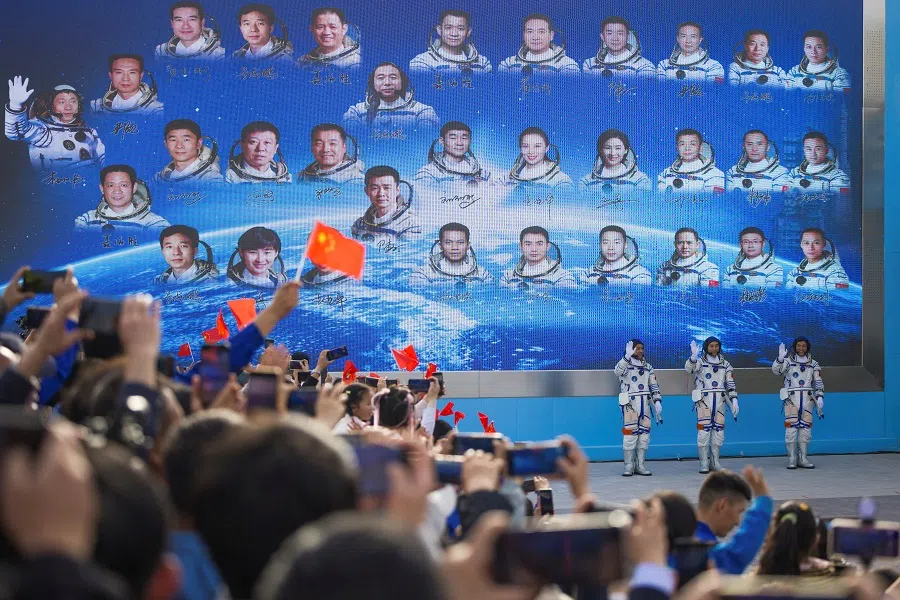In the new space battleground, will China be on the losing end?
Chinese military commentator Song Zhongping observes that space has become the new battleground for US-China and there is even a risk of the nuclear weaponisation of space. Will the alignment of allies in space be an extension of that on earth, potentially isolating China?

Recently, Russia vetoed a draft United Nations (UN) resolution on preventing nuclear weapons in space proposed by the US and Japan. Soon after, Russia put up its own draft resolution on the prevention of an arms race in outer space, which was vetoed by the US. With these mutual rejections, it is clear that space is becoming a new arena for big countries to fight over.
Space is a new battleground brought about by technological development. With the rise of human technology, man has gone from the Earth’s surface to the sky, from the sky to space and even deep space. As science and technology advances, the scope of battlegrounds keeps widening, not least into the new arena of space.
US’s dominance in space
In the 1980s, the Reagan administration had already seen space as a new battleground. The US’s High Frontier strategy set the acquisition of space superiority as a key mission for the US military. The Star Wars programme and its offshoot missile defence plans were all based on using space as a key arena for defence and offence.
As military technology for some countries kept improving, space becoming a new battleground became an inevitable reality. The US has continued testing the X-37B spaceplane; this is a weapon that could potentially carry both nuclear and conventional weapons while possessing incredible mobility, making the weaponisation of space a reality.
The US is opposed to the nuclear weaponisation of space because it wants to protect its own hegemony. Since it is already actively pursuing and leading in the conventional weaponisation of space, it advocates for banning nuclear weapons in this domain. However, it refrains from supporting broader restrictions on the militarisation and weaponisation of space.
Designating space as its primary battlefield, the US leverages space to attack targets on land and sea, conducting surveillance and intelligence operations. It also sees space as a critical battleground for intercepting enemy ballistic and hypersonic missiles, and targeting the opponent’s space assets.
... the evolution of space into a new arena of competition represents a pivotal advancement in human history — one that cannot be prevented.

Additionally, the emergence of space as a new battlefield is a natural evolution in human history. War first broke out on land, and with the improvement of technology, it expanded to the sea. During WWI, fighting extended from land and sea to the skies.
With the continuous development of rocket and missile technology, humanity turned its gaze to space. Space has not only become a battleground for various reconnaissance, navigation, and communication satellites, but also a crucial battlefield for some of the world’s major space powers to build new combat capabilities.
Seizing space superiority means a pre-emptive strike from space against nations lacking these capabilities. As such, the evolution of space into a new arena of competition represents a pivotal advancement in human history — one that cannot be prevented.
Nexus of US-China competition
China and the US are locked in a continuous rivalry as leading aerospace powers, each boasting space capabilities that outstrip those of other nations. With the ongoing operation of the Tiangong space station and regular manned missions by Chinese astronauts, both countries have heralded a new era of competition in the field of space exploration.
With legislation in the US imposing strict bans on space collaboration with China, even if both sides wish to cooperate, they would be unable to — competition is the only route.
Beyond vying for dominance in space stations, shuttles, navigation systems, surveillance networks, and communication systems, both nations are increasingly venturing into deep space exploration. This shift entails a transition from moon missions to ambitious endeavours aiming at Mars and other planets in deep space.
The most classic example would be the intense China-US competition on moon exploration. China announced that it would send astronauts to the moon for the first time before 2030, while the US’s Artemis programme also wanted to send astronauts to the moon before 2026.
Facing unprecedented challenges and spurred by a race to beat China to the moon, NASA has mobilized the Artemis program and partnered with Elon Musk’s Starship system. This move carries significant political implications, signalling a clear intent to outdo China in space exploration and moon landings.
The US sees sending people to the moon as a show of crucial technological improvement and a focal point in its comprehensive competition with China. Compared to the US-Soviet competition in the previous century to send people to the moon, the China-US competition of today is an all-round hybrid competition that spans many fields. Whether in military, economic, technological or deep space exploration spheres, competition persists on all fronts, characterizing the China-US dynamic as one of hybrid competition.
The purpose behind the US forming a new faction in the space arena is evident: they want these countries to collectively counter the common enemy the US has identified — China.
Forming factions?
The US is also currently forming a new faction in space. It would be more accurate to say that the Artemis programme is a code name for a new faction in space rather than a programme for sending people to the moon.
The US intends to broaden participation in the Artemis program by involving more countries already engaged with the International Space Station (ISS). Furthermore, it plans to extend the program’s reach to constructing a lunar space station.
The more than ten countries involved with the Artemis programme as well as the countries the US have extended invitations towards are mainly those that share the same ideology and values system with the US, and the US calls these countries “allies”. The purpose behind the US forming a new faction in the space arena is evident: they want these countries to collectively counter the common enemy the US has identified — China.

China’s development in the space arena has consistently aimed for diversity, with the hope of engaging more countries in its aerospace projects. But China would not give up on the basic principle of being independent and self-reliant, as it would construct its new strategy for space development based on “China as central, other countries as auxiliary”, such as helping Pakistan to launch a satellite for lunar orbit.
What is noteworthy is that this is fundamentally different from the new faction in space the US is forming. While the US perceives China as forming its own faction to oppose it, in reality, the US has initiated a new framework of confrontation solely with China, extending the competition between the two countries from Earth to the moon, and from the moon to deep space.
From Russia’s perspective, it still identifies as a Western country while concurrently hoping to maintain friendly and cooperative relations with countries in the East.
Russia may tilt to the US in space development
In the case of Russia, it is also looking to secure multiple victories when it comes to space.
Russia is a key partner in the ISS, and a key partner in the US-Russia collaboration in space. Even as the Russia-Ukraine military conflict is ongoing, collaboration between US and Russia with regard to space has not stopped. If not for the fact that Musk’s SpaceX possesses more powerful launch capabilities, the US would rely on Russia even more on the ISS.
Russia also hopes to cooperate with the US on the ISS more, to ensure that the ISS can last till 2030. At the same time, the US also invited Russia to join the Artemis programme, which showed that even as US and Russia are entangled in a New Cold War or a hybrid war globally, it would not turn its back on the other entirely — cooperation in the space sector is also more in line with the interests and security needs of both the US and Russia.
Russia is willing to be a part of China’s lunar base plans, but it might not completely close the door to participating in the US’s Artemis programme. Clearly, Russia is hoping to secure multiple wins in the space sector, and is more invested in its own national interests.
From Russia’s perspective, it still identifies as a Western country while concurrently hoping to maintain friendly and cooperative relations with countries in the East. This is especially because the notion of a multipolar world advocated by Russia is in line with its interests but is at odds with the US’s hegemonic thinking.
Space is destined to become the new battleground and a critical technological arena in the competition between China and the US. This rivalry is all-encompassing and the US’s suppression of China is for the long term. The US expects hegemonic status not only on Earth but also in space and deep space, while China is challenging the US on all fronts. All these factors indicate that the competition between the US and China will be protracted, intense, and potentially brutal.





![[Big read] China’s 10 trillion RMB debt clean-up falls short](https://cassette.sphdigital.com.sg/image/thinkchina/d08cfc72b13782693c25f2fcbf886fa7673723efca260881e7086211b082e66c)